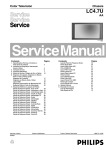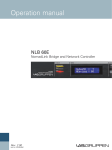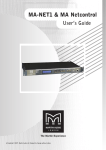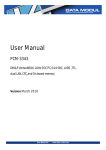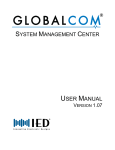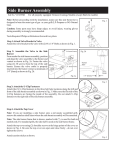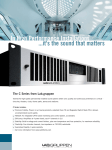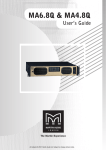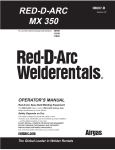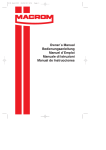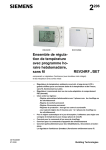Download Line-Xtension Service Manual
Transcript
Line Extension Circuit description and schematics for C 20:8X C 10:8X C 10:4X C 5:4X Some of the schematics included here are not complete, or up to date. They should be used for educational purposes only. INDEX INDEX ....................................................................................................................................... 2 SP20F – Circuit description ....................................................................................................... 4 Functional overview............................................................................................................... 4 Block diagram ........................................................................................................................ 4 Soft Start................................................................................................................................. 5 Stand-by (Auxiliary) supply................................................................................................... 5 Mains Detector ....................................................................................................................... 5 PowerGood_AUX .................................................................................................................. 6 PowerOn................................................................................................................................. 6 PFC......................................................................................................................................... 6 Resonant converter................................................................................................................. 6 PowerGood_2kW ................................................................................................................... 7 Service tips ............................................................................................................................. 8 SP20F Schematics .................................................................................................................. 9 AICO4b – Circuit description .................................................................................................. 13 Power supplies and power up/down..................................................................................... 13 Stand-by supply................................................................................................................ 13 Start-up ............................................................................................................................. 13 Local supplies................................................................................................................... 13 FanControl........................................................................................................................ 14 Control Ports ........................................................................................................................ 14 GPI ................................................................................................................................... 14 GPO.................................................................................................................................. 14 NomadLink....................................................................................................................... 14 Controller operation ............................................................................................................. 15 Controller ......................................................................................................................... 15 Analogue measurements .................................................................................................. 15 Digital measurements ....................................................................................................... 16 FanControl........................................................................................................................ 16 Signal flow ........................................................................................................................... 16 Input circuitry................................................................................................................... 16 Analogue control and monitor.......................................................................................... 16 Limiters ................................................................................................................................ 17 Clip limiter ....................................................................................................................... 17 Current Limiter................................................................................................................. 17 Average Current Limiter .................................................................................................. 17 Protections............................................................................................................................ 18 Turn off channels ............................................................................................................. 18 Low Impedance ................................................................................................................ 18 Short circuit ...................................................................................................................... 18 VHF.................................................................................................................................. 18 DC-Protection................................................................................................................... 18 Temp Protection ............................................................................................................... 19 DIP-switches ........................................................................................................................ 19 Service tips ........................................................................................................................... 20 AICO4b Schematics (Partly)................................................................................................ 21 SPSMR – Circuit description ................................................................................................... 29 SPSMR - schematics ............................................................................................................ 29 Front Panel ............................................................................................................................... 30 A10D – Circuit description ...................................................................................................... 32 Power supplies and power up/down..................................................................................... 32 Supplies ............................................................................................................................ 32 Power up........................................................................................................................... 32 Signal Flow .......................................................................................................................... 33 Enable/Disable of a channel ................................................................................................. 34 Protections............................................................................................................................ 34 VHF.................................................................................................................................. 35 DC-Protection................................................................................................................... 35 Temp Protection ............................................................................................................... 35 Crowbar............................................................................................................................ 35 Limiters ................................................................................................................................ 35 Clip limiter ....................................................................................................................... 35 Service Tips.......................................................................................................................... 37 A10D Schematics (Partly).................................................................................................... 38 SP20F – Circuit description Functional overview The power supply SP20F is used in the C-Series line extension amplifiers. It incorporates: • Universal voltage input, 90-265 VAC • Power Factor Correction (PFC) • Soft start • Fast mains unplugged detector • A highly efficient isolated resonant converter for the high power outputs. • A standby supply also used for lower voltages. Block diagram Soft Start [PFC] When the mains cord is plugged into the wall, the following will happen: The rectified mains will through D5 start to charge the capacitor bank C22-C25. The soft start circuitry will make the capacitor tank charge slowly with low inrush current. R33 is used as a current sense resistor and Q7 and Q4 is used to slow down this event. The voltage over the capacitor tank will rise slowly, and after about 1-2 seconds it will have completed it’s inrush cycle and R33 is bypassed via Q5, thus shorting the entire soft start circuitry. The node that in the schematics is named 400V, will be Vin * 1,41 (for 220v Mains it will be ~311V, for 110v Mains it will be ~155v). The circuitry will remain in this state until the external “Power On” is activated from the input board (PWR_ON_CTRL). Stand-by (Auxiliary) supply When the capacitor tank has reached about 80VDC the standby supply will try to start. [AUXILIARY] This converter is a self oscillating type and will change frequency depending on its load. The high voltage (>80VDC) is fed through R76 & R77 and D13 will make sure that the SOPS_STARTUP has a constant voltage of 12v. When the supply operates this voltage will be supplied from the winding through D16, thus relieving the stress on R76 & R77. This voltage will make Q10 conduct, thus making Q15 and Q12 to conduct. Now, current flows through the primary winding, building up a magnetic flux. The current will increase linearly with the time and so will the voltage over R62 & R78 current sense resistors. When the voltage is enough it will trigger Q14 to conduct, thus making Q11 to discharge C85 and Q12 gate. This will stop the current in the primary winding, and the voltage polarity on all transformer windings will reverse to discharge the magnetic flux. Mainly the transformer discharges the flux to the secondary side, building up the voltage over the secondary capacitors. During this time the voltage on pin 2 on the transformer will be positive, and through C35 and R89 it will keep Q10 from conducting. When the flux in the transformer has been discharged, the entire event will start all over again. D7 taps out a primary voltage 12V_Aux to be used on the primary side. Normally when IC5 optocoupler is not conducting current, the transformer is charged with a high amount of energy, transferring all the energy the transformer can handle. When the output reaches the desired voltages D49 will start to conduct, driving current through the IC5 diode. This will alter the sensitivity on the current sense circuitry, and make Q14 trigger on a lower primary current, thus transferring less energy. This regulation will make the primary side not to put in more energy into the transformer than we take out of it, thus keeping steady output voltages. When current flows in the diode of IC5, Q13 will start to conduct current, thus making Pwr_AUX, that goes beyond this page, to be -12v. Mains Detector [TOP] the Mains Detector is made up by IC1 and its surrounding components. When the mains go above 80VAC (~113VDC) the voltage on IC1 pin 4 will go above 6,2v (D2) thus making pin 2 discharge C7 rapidly. This will make pin 6 go below its reference thus making its output high. This will slowly charge C8 through R3 and when it reaches 6,2v pin 14 will go high, and the ENA will be high, thus bypassing the soft start and enabling the power supply to turn on. During this time pin 13 will be close to 12v. If the mains cord is unplugged, pin 13 will immediately go low, thus making the diode in IC2 conduct current, and disable PWR_AUX to reach the PowerGood. To the input board this will signal a “PowerFail” rapidly, thus making all circuitry turn off in a nice manner. PowerGood_AUX [TOP] When the standby supply has started and all auxiliary output voltages are stable Q1 will be pulled negative by the standby supply, as long as it’s not forced to ground by IC2. This will make Q1 to be high impedance instead of shorted. The input board senses this and uses this as a criterion for further startup. Now we have reached this power supply state for standby. It will remain in this state until we receive a “Power On” signal from the input board. This will only happen if the PowerGood_AUX is high impedence. PowerOn [PFC]When the input board puts ~3,3v on the PWR_ON_CTRL node, the diode in IC4 will conduct making the transistor in IC4 also conduct. If the ENA from the mains detector is high this will make Q9 to conduct, which makes the 12V_ON to be 12v. If the ENA from the mains detector is low, Q2 will conduct and prohibits Q9 from conducting. PFC The PFC is made up around IC3, which is the controller IC. The PFC controller is an advance integrated circuitry and I will not go into detail about its regulator function. When it functions as it should it should keep the capacitor tank (C22-C25) at 400VDC. When the 12V_ON is close to 12v IC3 will have supply voltage and start to generate pulses to Q3 via Q6 & Q8. When Q3 is conducting it will build up a magnetic flux in the coil L1. When Q3 is not conducting, the coil L1 will discharge itself via D3 to the capacitor tank, making the voltage over them be more than Vin*1,41. The main point of having a PFC is to make the current in to the supply to be shaped as the voltage, thus making the supply look like a resistive load on the mains. The controller ensures this by sensing the current by measuring the voltage over R36 & R43. Since the current has to have the same shape as the voltage, the IC3 also senses the voltage on the mains through R53. Several different regulators inside IC3 make the voltage and the current to have the same shape, sinusoidal on normal mains. The controller senses the voltage on the capacitor tank through R42 & R38 and ensures it to be 400VDC. Resonant converter [Resonance] the resonance converter is a self oscillating circuitry. But unlike the previous described standby supply, this converter will oscillate on the resonance frequency of the capacitors C50, C51, C52 and the coil L7. The converter is made up by IC13 and it surrounding components. When the 12V_ON is close to 12v IC13 will have supply voltage through D26 and R92. It will then start to generate pulses to Q18 and Q19. I will not go deeper into the primary side. There are 3 taps on the secondary side of the transformer, +105v, -105v and a 13,5v that is referenced to the -105v. To keep the voltages steady D20 will control the current through IC6 and make sure that there are 210VDC between the -105v and +105v. PowerGood_2kW [Resonance] When the +105v has reached ~80v the IC7 pin 3 will go above the (-) input thus making it’s output pin 1 be high impedance. When the 13,5v reaches ~11v Q28 and Q27 will make Q26 conduct current, thus enabling the -105v reach the PwrGood comparators in IC7. When the -105v reaches about -80v, pin 6 on IC7 will go below its reference and the output pin 7 will be high impedance. When both pin 1 & 7 on IC7 is high impedance Q34 will conduct current, thus making Q35 gate negative making it to be high impedance. Thus the PowerGood_2kW is released. This is sensed by the input board and when Q35 is not conducting, this is interpreted as the resonance converter is up and running and the input board can start all its functions. If the PowerGood_2kW is not released, the input board will remain in standby. Service tips - - - If the +/-105v (and the 13,5v) is very low although the switches Q18 and Q19 is switching, you probably have short on the outputs. Please disconnect all outside circuitry (by removing all amplifier fuses) to see if it starts up. When the outside short has been found, continue repair there. The PowerGood signal controls the power state on the input boards, and the power state on the entire device. So start by checking these. They should be above 2v to signal good. If they are below, they signal fail. If the resistors R62 and R78 in the auxiliary supply have opened, the entire primary will end up in an “in-between” state instead of switching between on and off. If the auxiliary supply is not switching, check these before going into deeper fault localizing. SP20F Schematics AICO4b – Circuit description Power supplies and power up/down. Stand-by supply The power supply in the unit has a standby supply which is always on when the mains cord is plugged in. Once this converter has enough supply to generate good output power it will generate a “PowerGood_Aux”, which will go high. Before this it can only be powered through NomadLink. [NLIPs] When a Voltage is present on NomadLink it will go through D407 and if the standby supply is off it will go through Q410. When the standby supply is on, it’s PowerGood will, through Q422, turn off Q410 and feed +12v from the standby supply through D408 to the same node. The existence of Nomadlink power is sensed through R475 and R472, and when this is high it will activate the Com-Led by pulling the ComCt high. This will turn on Q416 and turn off Q411, thus leading the current through the Nomadlink diode which is connected between Com+ and Com-. Q412 & Q414 forms a current limited +5v regulator. This is biased from R481. When the voltage over R482 exceeds 0,6v the regulator will lower its output voltage until the current remains constant. This +5vP supplies everything that needs to be on in standby, most important the controller U407. [UPcB] The controller uses a lower voltage to operate, and this is made through Q409 that will make the voltage be 3,0 – 3,6 V. [LVPsB1] In standby all other voltages is turned off by Q401 and Q408. Start-up There are 3 different ways to turn on this amplifier; by NomadLink command, by GPI (only when Nomadlink is disabled by dip switch) or on the front switches. The Controller will scan the front switches for On/Off & Remote. Manual – on or off will directly generate and internal request to turn on (or off) the PSU. When in Remote the same request will come from either Nomadlink or GPI (depending on the switches). This internal request will be generated to the PSU When “PowerGood_Aux” is high. This means that if the standby supply is not on, then the controller will not start the amp. When the standby supply is on and a Power On is requested the Controller will pull PwrOnCt high and the power supply should start shortly after. When the supply has reached sufficient output voltage it will release the PwrGood105V. Local supplies When PwrGood105V is high, the controller will wait about 0,6s before doing anything, and if all is ok, it will then go over into operate-mode. [LVPsB1] When PwrGood105V goes high, Q406 & Q402 will turn on and turn on Q408 and Q401. U403 will regulate the voltage between -18 - +18 to be 35,5v – 35,9v (if they are not, adjust VR401 until they are). Since this voltage from the supply is floating, U401 sets its reference to ground to be exactly at 50% of this voltage. U401 will push and pull Q405 & Q403 until AG is equal to the voltage division R408 and R410. This makes the +/- 18v. U406 is a +5v regulator which will generate a local +5v (this is not the same as +5vP standby voltage!). FanControl [LVPsB1] U402 & Q404 forms the Speed control circuitry for the fans. It is basically an inverting amplifier that can open and close Q404 through D401. If the FanCt (from the controller) is kept high the fans will be at low speed. During power on the fans will start up with a high voltage to get them running, this is done by C409 being discharged at the beginning. The controller measures the temperature on the amplifier modules. And if they go above ~40deg C, the controller will lower the voltage on C409 by Pulse Width Modulating the FanCt signal. Control Ports GPI [NLIB/GPIO] the GPI ports are used to power on/off the amplifier if the criterion for this is met. This is; if front switches are Remote - On. The DIP switch is set to GPI. The circuitry for GPI 1 and 2 are identical. If GPI1a and GPI1b are connected to each other, current flows through Q427. This opens Q421 and pulls this down through R486. This signals to the controller that the GPI1 is activated. During normal mode, by closing these connectors for more than 100ms will make the amp go on and when closing them again a second time the amp will go off. The same goes for GPI2. By activating the dip switch “GPI2 level trig” GPI1 is discarded. By closing GPI2 for more than 100ms the amp will go on. When opening GPI2 for more than 100ms the amp will go off. GPO [NLIB/GPIO] There are 2 semiconductor relays that control the GPO ports. By driving current through the diode the relay closes. The GPO2 is connected to the local +5v, so this will be activated as soon as the amplifier is on. The GPO1 is connected to the controller serial circuitry and will be activated by the controller when there is a fault on any channel. NomadLink [NLIB/GPIO] NomadLink is a transformer isolated serial communication network. Communication that comes into the IN port will only reach this device. Communication on the Out port will be directly transferred to the IN port. U417 has the capability to electrically exchange these ports so they switch functionality with each other. This is done when devices receives communication on the Out port only, and is controlled by the controller N/R pin, ~0v means normal, ~3,3v means switched ports. When NomadLink is turned off by the dip switches, the controller pulls NMLOn* to ~3,3v. This disables the NomadLink completely by opening all the switches inside U417. The NMLOn* should be close to 0v normally. [UPcB]When no communication is present (NML cable unplugged), the processor’s transmission pin (Tx) pin will be internal disconnected and will be ~1,65v because of the voltage division between R461 and R470. [NLIB/GPIO] this voltage will be gained in U413(1,2,3) to be ~2,5v which will go through R473, through the transformer and end up at C432. U413(5,6,7) will in this state only transfer the 2,5v DC to it’s output, and through R462, through the transformer and to C433. U414 will detect any communication and in idle it will leave a high output of about 3,3v. During communication all these voltages will have an AC square wave signal on them, and it requires a digital storage oscilloscope to analyze them. If the DC voltages are correct, then it usually works. Controller operation All levels on the IO pins on the controller is interpreted as <1v low (‘0’) and >2v as high (‘1’). Any input that is more than ~4,5v is hazardous to the controller pin. Controller The first criterion for the controller operation is that it has operating voltage on pin 5, 17 and 38. This should be over 2,7v (usually between 3,0 – 3,6v). The second criterion is that the RESET pin (4) is high. The third and final criterion is that the controller has a clock source. This could be measured on pin 8 of the controller using an oscilloscope. The wave shape does not need to be a perfect square wave shape; it looks more like a triangular wave. But it should run at the frequency of 7,37 MHz. During standby the controller uses the following pins: NMLOn* Out-port low -> NomadLink on, high -> NomadLink Off GPI Level In-port, Reading on dipswitch. GPIMode In-port, Reading on dipswitch. GPI1 In-port, Reading on GPI1 state. GPI2 In-port, Reading on GPI2 state. PwrOn/off In-port, Reading on Power On/Off switch state. RemOn/Man In-port, Reading on Remote On/Off switch state. NML Out-port, NomadLink direction. low = normal, high = switched PhSen In-port, high when NomadLink is connected Int0 In-port, PowerGood_Aux sense. Int1 In-port, PowerGood_105v sense. ComCt Out-port, controls ComLed, low =ComLed not lit, high =ComLed lit. MuteAll Out-port, when low all channels forced silent. PwrOnCt Out-port, when high the main PSU should start. When the controller goes into operating mode, 3 additional functions is started in the controller: Analogue measurements The Analogue measurements will start, for this to happen, the analogue to digital converter in the controller needs to be supplied. This is done via R436 to pin 27. This should be the same as the controller supply voltage (3,0 – 3,6v). The A to D converter also requires a reference voltage to function properly; this should be 2.49v – 2.51v and could be measured at pin 29. U405 (on top schematics) will route the analogue level on its input pins to the controllers, AdIn pins, which are analogue input pins. The controller decides which input that will be measured by changing the states on AMux 0:2. Digital measurements The digital data gathering interface will start. Clk, MISO, MOSI and CS will go through U409 & U411 to convert it to 5v logic. When CSA-D is pulled low (<1v) then Clk, MOSI & MISO will be routed to the lower board circuitry (containing the information for ch A-D) and to the front panel. When CSE-H is pulled low, then Clk, MOSI & MISO will be routed to the higher board circuitry (containing the information for ch E-H). The data gathering line consists of a number of shift registers connected in series (U1, U101, U201….). when CS goes <1v it will take a sample of the data on the input pins, and when a clock pulse are sent to them, they will shift their data one step closer to the controller. The controller will shift it into its memory in the same manners. After all data has been shifted in, the controller stores the value as a representation of what’s happening on the channels. The same goes for data shifted out of the controller. When CS goes >2v the inputs will be ready to receive new data, and the outputs will be what the controller shifted to them. FanControl The analogue measurements on the temperature on the modules will yield a specific fan value. When the temperature is below 40deg C the fans will be at idle, and FanCt should be close to 3,3v. Between 40 and 60 deg C the fans will be temperature controlled, the higher the temperature, the lower the voltage. When the temperature exceeds 60 deg C the fans will go at maximum, and FanCt should be close to 0v. Signal flow Input circuitry [AIG2B] The input circuitry is made up by U6 and U5. U6(5,6,7) is an inverting amplifier and its gain is -1 through R58 & R59. This is fed into a summing amplifier U6 (1,2,3). This amplifies signals with the same phase through R56 & R57. Its gain is set by R48 and depending on Q18 can be -6dB (Q18 off) or 0dB (Q18 on). This -6dB switch only exists on Ch A, C, E, G and is only used when bridging 2 channels (in bridge mode, Ch B, D, F, H input circuitry is not used). U5(5,6,7) is when Q32 is on an inverting amplifier with gain ~ -1. Q32 is opened by selecting 35Hz high pass filter on the dip switches, this causes C34 to form a 35Hz high pass filter. U5(1,2,3) is preceded with a damper network formed by R54, R53 & Q15 (R52 is added to keep Q15 from distorting the signal when opened). When Q15 is on this network damps the signal 3dB and 0dB when Q15 is open. This signal is fed into U5(1,2,3) which has a gain set by R42, R41 & R40, if Q14 is open. When Q14 is closed R40 is shorted and electrically omitted. U5(1,2,3) has Gain +3dB when Q14 is open and +9dB when Q14 is closed. Q15 and Q14 are controlled by the gain switches on the rear on the amplifier. Analogue control and monitor [ACM1A] the signal goes through the front panel attenuators, and into the ACM1A schematic page. It goes through R31 to U2(1,2,3). U3 is an automatic limiter component. By running current through its diode, the signal is limited. During normal operation there shall be no current going through this diode, and this component has no affect on the signal. U2(1,2,3) is a non-inverting amplifier and sends the signal out of the block again. On the top schematics we can see that on ch A and C they are fed directly back in. On ch B and D they go through a relay (RE401, RE402). This relay is activated when bridging 2 channels. When Ch A & B are bridged Ch A’s input signal is fed to Ch B but in opposite phase. The signal then goes to U2, which is a balanced amplifier. It senses the signal ground on the amplifier modules and cancels them out. This rejection is trimmed in production by tuning VR1. After the amplifier modules the signal comes back trough the output filter coil K1. This coil has an extra winding on it, and it is used to sense the current that goes to the speaker. This signal is fed into the amplifier U7, which compensates for the frequency dependency in the coupled coil K1. On the output of this amplifier is a signal that should be in direct proportion to the current going to the speaker. Limiters Clip limiter Whenever the UClip signal is pulled low, and Clip mode is set to soft (dip switch – enables Q5 to lead current) there will go current through the LED in U3, thus limiting the signal. The clip limiter is made up of 2 circuitries. When the VPL is set at the highest voltage, the amplifier module will clip whenever the output signal reaches the rail voltage. If this is the case, the amplifier module will pull down the UClip to ground. When the VPL switches are set to a lower voltage, it will generate a DC voltage VclCt that is fed into U4. Whenever the signal on U2:3 goes above this, Q13 will pull the UClip signal to ground. When UClip is detected the signal is also fed to the shiftregister U1(13) through a diode. This tells the controller that the channel clips. Current Limiter The Isen signal (output from U7) is a representation of the current going to the speaker. This is fed into U10(4,7). This circuitry is a window comparator, and when the signal exceeds the +/- voltage over R90, the output U10(1,2) will go to -18v. This triggers Q27 and Q25 to conduct current, thus pulling the Ilim signal low. This will through R28 and D2 lead current through the diode in U3, thus limiting the signal. When ILim is detected the signal is also fed to the shiftregister U1(14) through a diode. This tells the controller that the channel current limits. Average Current Limiter The Isen signal is fed into D1 to rectify the signal. When this signal has amplitude enough it will charge C29, fairly slowly. If this signal is sustained for about 200ms C29 has been charged enough to trigger Q16 to limit the signal. When this detector is active the signal is also fed to the shiftregister U1(7). This tells the controller that the channel limits. Protections Turn off channels To turn of a channel, 2 things need to happen. The signal needs to be lowered, and this happens when the controller sends out mute to the channel. This will trigger Q4 to draw current through the diode in U3. Shortly thereafter Q21 pulls down the En_A signal going to the amplifier modules, thus turning off the output transistors. There is a short delay between the signal is limited to the output stage shuts down. This delay is to make the shutdown sound more nicely, and is made out of D8, R47 & C25. There is also a feedback signal telling that the channel has been muted through R50. This is fed into the shift register U1(6). Low Impedance The controller samples the input level on its analogue to digital converter. It also receives signal on the shift register when the channel is in current limiting. When the controller detects that a channel is in current limiting, it will then check the voltage input, and if the voltages is so low that there must be a load <1 Ohm on it, it will turn off the channel for 6 second. The controller will during this state lit up the CPL diode on the front. Short circuit Since the current limiter is fairly slow (attack time of ~1ms) there is a possibility that short high frequency spikes could pass through the amplifier. This could be dangerous to the output transistors, so there is an additional protection for this. The ISen signal is fed into U10(8,11) and compared to the +/- voltage over R89. This should happen when the output current exceeds 30Apk. If that is the case, then the outputs U10(13,14) will go to -18v. This will turn on Q29, Q23 & Q26 this will immediately shut off the output transistors. Instantaneously Q22 and Q28 will be triggered and tell the controller that this protection has kicked in. The controller will then mute the channels (although they are already off), and then release everything 6sec after. The controller will keep the LED CPL constantly lit on the front during this state. VHF The VHF protection is located on the amplifier module, but when it is activated the En_A will go low. This is fed into the shift register U1(1) and when this has been pulled low while Mute and short circuit is inactive, then it will be interpreted as a VHF protection. The controller will keep the channel muted for 6s and lit up the VHF led on the front. DC-Protection When DC appears on the output a protection circuitry on the amplifier module will kick in and destroy the channels fuses. When this happens the DCProt signal (which normally should be close to 0v) will go either positive or negative from the amplifier modules (depending on which fuse (or both) that has been destroyed). This will trigger Q3 and send the information to the controller. The controller will shut off the channel (mostly to prevent any further damage). The controller will indicate FAULT on the front by lighting up the VHF and CPL. Temp Protection On U405 (top schematics) the channels temperature is monitored. On the amplifier modules there are a temperature dependent resistor that is mounted on the cooler. This will together with the impedance network R1, R430 translate to a voltage that is proportional to the temperature. If the voltage on U405(1,5) goes below 0,5v this means that the temperature on the module have reached ~100deg C, then the controller will shut down the channel until it reaches ~90deg C. the controller will also lit the Temp led on the front to indicate this. DIP-switches The HP Filter switch is read by the controller through the shift register. It will also generate a 0v / -18v to the JFet switch. The Clip Mode switch is read by the controller through the shift register. It will also pull down the 5v to ground, thus turning off the UClip signal to the automatic attenuator. The VPL switches is read by the controller through the shift register. These switches will generate a DC- voltage that is used by the VPL circuitry to clip the signal at the correct level. The Bridge switch is read by the controller through the shift register. It will also feed +5v to the relays that routes the signal to the other channel. Also it will generate a 0/-18v to trigger the -6dB JFET on the input circuitry. The GAIN switches is read by the controller through the shift register. They are also used to generate 0 /-18v to the JFets in the input circuitry to set correct gain. FAN Masked switch is read by the controller through the shift register. It is used to make the controller to count in the output sound pressure to control the fans. The GPI Level and Mode is sent directly to the controller, since it needs to be sensed even in standby. Service tips - - During service of an 8 channel amplifier, it is safe to remove the AICO4bExt board from the AICO4b board and run the amplifier only with the lower board. You do not need to disconnect the Ch E-H amplifier module. If the amplifier does not start up, set it to Manual-On and follow the scheme below: +12v from supply? no continue repair on supply yes Is +5vP ok? Faulty +5vPh regulator [NLIPs] or shorted 5vPh High no check PwrGood_Aux continue repair on supply low yes +9v from supply? yes Pin 42 high and 43 low on U407? yes no continue repair on supply no check connection to the power switches PwrOnCt High? no yes PwrGood_105v high? yes +/-18v & +5v ok? check controller operation no continue repair on supply no repair regulators in [LVPsB1] ok Connect the device to NLB60E and check the software yes The board should be powered up. - If the communication led is blinking rapidly (~3 blinks every second) instead of once every other second, when connected to a NLB60E. The controller is stuck without valid software. Please contact LAB.Gruppen service department on how to download new software to the amplifier. AICO4b Schematics (Partly) SPSMR – Circuit description The SPSMR board is a very simple board, made up just to signal the power switch states to the input board. It is supplied with +9v from the input board. When the power switch is set to on, the +9v is connected to the “PowerOn/Off” signal, thus signals to the input board that this switch is set to on. The remote switch is connected after the power switch, and can thus only be monitored when power is set to on. When the power switch is set to on and the remote switch is set to remote, the +9v is connected to the “RemoteOn/Off” signal, thus telling the controller that the remote switch is set to remote. When +9v is present at the “RemoteOn/Off” signal, the remote LED D1 will be lit. Below truth table will give the signal value for each switch: Power Remote “PowerOn/Off” “RemoteOn/Off” Off Manual 0v 0v Off Remote 0v 0v On Manual 9v 0v On Remote 9v 9v SPSMR - schematics Front Panel The front panel is controlled from the controller on the input board. All diodes except for one, the NomadLink LED, works in the same manners. The NomadLink LED is supplied from the input board, so it has the ability to be lit even when the front panel registers are not powered (as in standby or off). The front panel is an extension to the AICO4b board shift registers, but they are also supplied with an En (Enable) signal. This signal, when pulled low, makes all shift registers output high-impedance. This En signal is mainly used upon boot up to make sure that the registers contain valid data before releasing current through the LED’s. The controller drives the LED’s by at the same time feed the registers with data for a given row of LED’s (1-7) together with the intended row (ChA – ChH) selector. When a row is selected the corresponding ChX pin is driven low, this enabling the transistor for that row (Q1 – Q701) to conduct current. When a row has been updated the controller moves on to update the next row and when it’s finished with all rows, it starts all over again. A10D – Circuit description The A10D Amplifier board incorporates a 4 channel high power audio amplifier. The board is build up as 2 stereo amplifiers. Most supplies are shared between the 2 channels and split to the next 2 channels. The A10D is a class D amplifier, and the operation of a class D amplifier differs a lot from class A, B, AB or H amplifier. Instead of amplifying the signal using resistive elements, the output is generated by 2 switches that are either on or off. Power supplies and power up/down. Supplies The Amp-modules requires several supplies. The +/-105V and 13.5V are split in two, one for each pair of channels. Each of the four channels has their own +/-12V supply. Furthermore for each channel +/-5V is generated on the module. +12V +5 V AGND -12V -5V -105V AGND +13.5V(Ref to -105V) -105V +12V +5 V AGND -12V -5V +12V +5 V AGND -12V -5V -105V AGND +13.5V(Ref to -105V) -105V +12V +5 V AGND -12V -5V Figur 1 – Power supplies Power up If the +13.5V is not present on a channel it won’t operate at all. The voltage can be measured at the driver at TP88(TP103, TP304 and TP319). Remember that this voltage is referenced to -105V. If any of the 6 remaining supplies is missing there might be some switching but the switching frequency won’t be correct. It is most likely that there will be no switching at all. The switching frequency can be measure on the power PWM at TP101(TP116, TP317 and TP332) and should be between 400kHz and 500kHz square wave reaching from +105v to 105v. It is important that this square reaches the positive and negative rail, otherwise the transistors are not completely on and they will get very hot. +/-12V can be measured at the OpAmp (IC13 , IC22 , IC9 and IC10) on the supply pins 4 and 8 respectively. +/-5V can be measured at the OpAmp (IC5 , IC21 , IC14 and IC19) on the supply pins 4 and 8 respectively. +/-105 should be measured at the amp-side of the fuses on the top-side of the PCB. These 6 supplies are all referenced to AGND. Signal Flow [TOP] The signal enters the board through the ribbon cable. For Ch A the signal is located on pin 4 (ground) and 5 (signal). It then goes into the feedback schematics. [FEEDBACK]. The signal goes into the balanced receiver IC13(1,2,3). The output pin 3 is fed into the high frequency amplifier IC5(1,2,3) and then IC5(5,6,7). At this point the signal is a square wave. It is then fed into the comparator IC1 and through the gates IC6 & IC7. Up to this point all signals can be measured using an oscilloscope connected to ground. Q7 & Q8 transfer the pulses to -105v so to continue to follow them beyond these transistors requires that you ground the oscilloscope in the -105v (beware if the scope is grounded in chassis ground, connected in a grounded mains or similar you could short the -105v to ground this way, and possibly destroy the oscilloscope and/or the amplifier). [POWERGAIN] the pulses reach the driver IC11 pin 1 and 2. The driver generates output to turn on or off Q10 according to the pulses on pin 1. This is made by driving pin 5 to about 10v over -105v. Q4 and Q5 amplifies the current so the transistor turns on and off fast enough. The driver generates output to turn on or off Q9 according to the pulses on pin 2. This is made by driving pin 7 to about 10v above the output signal. Q3 and Q6 amplifies the current so the transistor turns on or off fast enough. To measure this signal, the oscilloscope must be grounded on the TP101. When Q9 is on TP101 is ~+105v, which means that the driver must supply +105v + 10v (=115v) to Q9 to keep it conducting. This is done by having a capacitor, C38 connected to the switching node TP101 that charges itself when Q10 is on. D24 makes sure that C38 is never charged to more than 15v. this voltage is then used to supply the output driver IC11 pin 8, and to supply the driver transistor Q3. Enable/Disable of a channel Figur 2 - Enable circuitry To be able to disable/enable the amplifier two 2-input NAND gates have been implemented. If the ENABLE is pulled low the output of the NAND is high. When the enable pin is released (the module has a pull up resistor to +5V) the NAND gates just operate as inverters on the signal from the comparator TL3016. Protections On the Amp-module different protections have been implemented on each channel: • VHF • DC • Temp(PCB) These three protections (VHF, DC and Temp) all pull the ENABLE LOW. Well not completely to 0V but to about 0.6V. By measuring the ENABLE voltage you can determine if the Amp-module protects itself (ENABLE=0.6V) or it is disable from the input-board (0V). A special case is if short-circuit has occurred. Then the ENABLE voltage is pulled LOW (0.6V) by the AICO-board and the Ilim LED is constantly lit on the front. Figur 3 - Protections circuitry VHF If VHF occurs on the output the voltage over C224 (C125, C209, C108) goes up and triggers the latch Q47 (Q20, Q41, Q22). DC-Protection If low positive DC occurs for some seconds the voltage over R275 (R302, R257, R88) goes up and triggers the latch Q49 (Q40, Q43, Q23). If negative DC occurs for some seconds the voltage over R276 (R318, R258, R89) goes up and triggers the latch Q49 (Q40, Q43, Q23). Temp Protection If the temperature on the PCB reaches approximately 100degC the voltage over R296 (R300, R123, R293) goes up and triggers the latch Q59 (Q60, Q28, Q30). Crowbar For safety reasons each channel has a crowbar in case an output Power MosFET is shorted. When high DC appears on the output a protection circuitry will kick in and destroy the channels fuses. At the same time the FUSEN goes HIGH or LOW . Limiters Clip limiter The amplifier module will clip whenever the output signal exceeds the rail voltage. If this is the case, the amplifier module will pull down the UClip to ground. Figur 4 - Clip detector In case the Amp is in hard clip the error signal in the feedback goes above normal level in the attempt to compensate the lack of output voltage. This error signal is fed through R235 (R224, R69, R3) and compared to supply voltage dependant limits at IC20 (IC18, IC12, IC2). When clip is detected by IC20 (IC18, IC12, IC2) output goes high and it makes Q56 (Q53, Q26, Q1) pull the Vclip to ground. Service Tips • • • Always make sure that the supplies and the EN signal is correct. If the amplifier fuses are continuously blown, remove the output FETs and exchange the fuses. Set the input board to hard-clip mode and feed the channel with a 1 kHz sine wave (VPL indication on the front is normal in this case). Instead of high frequency pulses you should now have 1 kHz square wave pulses. Follow the pulses on the board and see where they stop. If the amplifier is continuously in VHF protection, then it should retry every 6 second (seen as a short blink on the front). If not, then the protection circuitry is faulty. A10D Schematics (Partly)












































